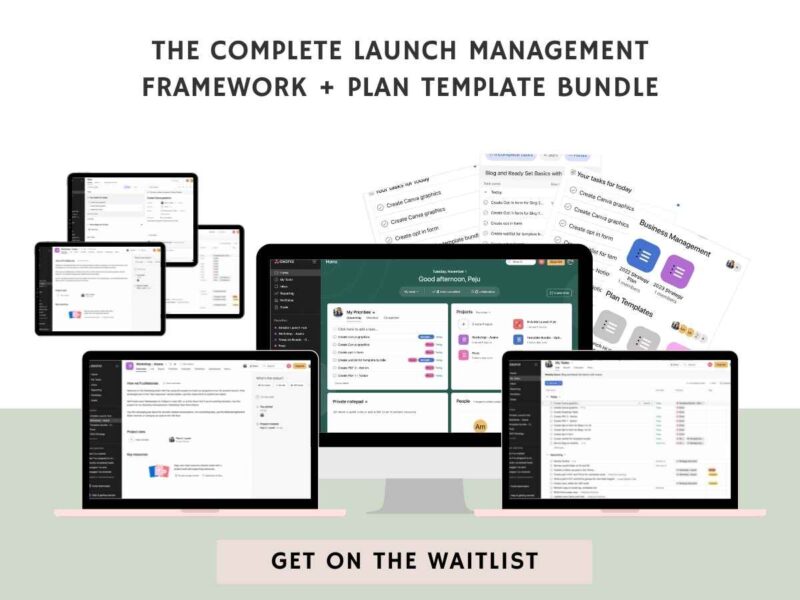Creating a plan or schedule is more than just adding tasks, assignees and due dates to a project management tool and hey presto you’ve got a plan.
Literally, anyone can do that.
Planning is an art.
Did you know that in project management, there is a role dedicated to project planning?
Yep, there are individuals hired specifically to plan projects and oversee the portfolio of projects.
This is all they do.
They don’t manage projects.
They just handle the planning.
They identify tasks and milestones
They estimate the duration of tasks and resources required.
They identify the dependencies between the tasks within a project and dependencies between projects within the portfolio.
They regularly update and review the schedule throughout the project to make sure it stays up-to-date.
They make sure there is capacity within the projects to deliver the whole portfolio.
Now you may not be developing innovative software or have a portfolio of projects to manage in your business.
But you probably have your business-as-usual activities alongside planning or executing a launch, so it’s a good idea to think of this aspect of your business as your portfolio of projects.
Here are some things to consider when creating a launch project plan
1. Create a framework or guidelines for managing your launches.
This includes things like the scope of the launch including its goals, objectives, deliverables, and timelines, team communication, risk management, quality management and criteria, change management and processes like the launch debrief process etc.
Without the framework, the schedule or plan is compromised before you begin to execute the launch. Your processes for tackling certain things you’ll come up against during the launch need to be defined otherwise when you run into challenges, there will be significant delays to the launch because you are trying to figure out a solution while in execution mode.
Once the framework is completed, you can then move on to create the project schedule in Asana.
2. Think about other projects and activities happening concurrently to ensure you and your team have the bandwidth to do it all comfortably.
When I create launch plans for clients, I don’t plan their upcoming launch in isolation, I’m looking at the other projects and activities happening simultaneously in their business and how everything fits together.
Even if you don’t have other projects running concurrently, you must have business-as-usual activities happening every day. It is important to make sure that you and your team have the bandwidth to do it all.
3. Think of all the things that could mess things up or cause delays and add some buffer to your schedule.
From experience, I know that things don’t always go according to plan so I always brainstorm and think about all the things that could cause delays. Things like approving deliverables, team members getting sick, tech issues etc.
You may then want to build some buffer into my plan, especially around critical tasks. The amount of buffer added varies depending on the scale of the launch as all things need to be considered, but on average I add about 30 – 40 % buffer. Sometimes more, sometimes less.
4. Consider the availability, expertise and current workload of team members before allocating tasks.
When allocating tasks to team members, it is important to consider their availability, expertise and current workload.
We don’t want team members overloaded and potentially burning out.
We also want to make sure we have the best person for each task to reduce having to course-correct and redo work that falls short of set standards.
5. Regularly maintain and update your plan to ensure you stay on track.
Creating a plan is never a one-time thing. You’ve got to maintain and update it regularly to make sure that everything remains on track.
This includes tracking progress, identifying any delays, and adjusting the timeline accordingly.
If you are not working with a launch consultant or manager, it is important to consider assigning someone on your team as the owner of the plan and keep an eye on things to ensure that everything stays on track.
This is an insight into the level of detail I go into when I create launch plans and schedules for client launches to ensure…
- Timelines and deadlines are met
- Consistent and enjoyable launch experience for their team and audience
- Set standards and processes are being followed
- Improved and informed decision making
- Improved problem-solving and fewer problems in the first place because you have a defined framework
These are just some of the benefits of having the structure and systems necessary to successfully execute launches.
So, to sum it up:
When you’re creating a project schedule, make sure to start with the framework/plan. Also make sure you’re thinking about all the tasks, the people doing them, and the external factors that could impact your timeline.
And don’t forget to regularly check in on your progress and update your schedule as needed. With these tips in mind, you’ll be well on your way to project success!
If you are committed to developing structures and systems that streamline and infuse the ‘soft life’ energy into your launches and team management and you need help with this, then apply to work with me here.









